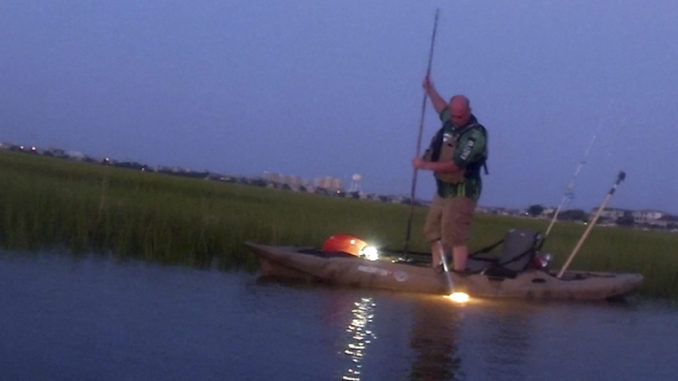
Paddle craft are a good platform for flounder
It was a few hours after sunset. The tide was coming into the marshes lining the Intracoastal Waterway. Several boats were already floating the various channels with lights beaming.
There was also one kayak.
Standing on the platform of the sit-on-top, pushing forward with a long bamboo pole, I was looking for one particular fish. It took me several trips to learn to spot them. After all, the brown skin with white spots blended in well with the sandy bottom.
Flounder are a favorite saltwater fish among Carolina anglers. The manners in which the tasty flatfish are taken are abundant, including gigging.
Flounder gigging has a dedicated following across the southeast. And a number of products have been introduced specifically for gigging. Submersible lighting systems ranging from $50 for a basic 100-watt bulb screwed into a base with a glass housing and a feeder wire to hook to a battery to several hundred for LED bars that can change colors to penetrate the water, whatever its clarity. I mounted a simple setup with a single bulb to the side of the kayak.
As the tide begins to rise, flounder find their way back into the channels in the marshes and lie in wait for their prey to swim past. They gently embed into the soft, muddy bottoms, often leaving only their eyes exposed. It takes a little practice in knowing what to spot.
Wading beside the kayak is also a good strategy
It is quite common to see boats lighting up the water after dark in search of the affectionately named doormats. Occasionally, someone walks along smaller channels between the sea grass with a hand-held light and a floating cooler in tow. I reasoned that a kayak should be able to navigate these shallows with little trouble. I was right.
In calm waters, a kayak can do anything a bigger boat can do. With a sturdy and stable sit-on-top, it is not too difficult to use a gig as a push pole and keep balanced. Even when other boats left their wakes, I was able to maintain a standing position with little trouble.
The flounder light is powered by a 12-volt car battery I keep in the rear of the kayak. I also use strap-on head lamp to help me see and warn boaters of my location.
Standing on the kayak and using the gig to push, I focus my attention on the bottom, looking for a wallowed-out football shape. Of course, with flounder, a minimum-size limit is enforced, so you have to be able to judge how long the fish is before you strike.
After putting a few flounder in the cooler this way, I tried something else. Plopping down in the water and fastening the kayak to my vest with a paddle leash, I used the kayak as my cooler and battery float. Having used an inner tube the same way in the past, the kayak works even better, and it is quicker to paddle out rather than walk out of the marsh.
In other words, a kayak’s use is only limited to your imagination.



Be the first to comment